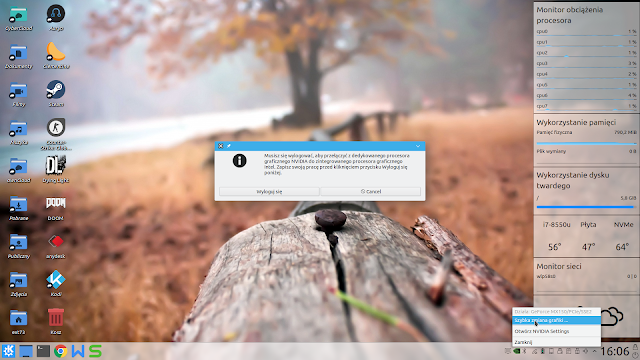Udostępniliśmy najnowszą Mesę 3D 20.1.0 - build ten został
przez nas zoptymalizowany m.in. na poziomie kompilacji kodu wynikowego, co
skutkuje wyższą wydajnością oraz responsywnością tych sterowników.
Kolejną zmianą jest przebudowana całkiem na nowo sekcja sterowników Nvidii.
NeteXt'73 automatycznie rozpoznaje z jakim rozwiązaniem ma do czynienia, albo
samodzielny układ Nvidii, albo hybrydowe połańczanie Nvidia/Intel = Optimus.
Po raz pierwszy przeszliśmy w przypadku Nvidia Optimus z Bumblebee, na
Nvidia PRIME oraz dodaliśmy zmodyfikowany przez nas
Prime Indicator. Na tę chwilę przewidujemy dwa tryby pracy: jako układ
graficzny Intela [oszczędność energii] oraz w trybie wydajnościowy, jako układ
Nvidii. Kolejną zmianą będzie dodanie trybu ondemand, a zatem praca na
układzie Intela, z możliwością ładowania i wyładowywania sterowników Nvidii
oraz uruchamiania GPU Nvidii w tle. Na to rozwiązanie nie zdecydowaliśmy się
ze względu na jeszcze nie w pełni realizowana obsługę procesu zarządzania
energią dla układu Nvidii w tym trybie. Na tę chwilę skutkuje to zatem stałym
działaniem układu Nvidii w tle, co w przypadku pracy na baterii skutkuje strat
ok 20-40 % czasu jej pracy. Myślę, że do 2-3 miesięcy uda się rozwiązać i ten
problem - wtedy wdrożymy w Prime Indicatorze także i takie rozwiązanie oraz
dodatkowe wdrożenie uproszonych mechanizmów wybierania na jakim układzie
graficznym ma działać dana aplikacja.
We have released new kernels v76.15 [based on Linux-5.6.15 sources] in
Premium & Standard version.
We have released the latest Mesa 3D 20.1.0 - this build has been
optimized by us, including at the compilation level of the resulting code,
which results in higher performance and responsiveness of these drivers.
Another change is the Nvidia driver section rebuilt completely. NeteXt'73
automatically recognizes what solution it is dealing with, either a standalone
Nvidia chip or a hybrid combination of Nvidia / Intel = Optimus. For the first
time, we switched in Nvidia Optimus from Bumblebee, to Nvidia PRIME and
added the Prime Indicator modified by us. At the moment we anticipate
two modes of operation: as Intel's graphics [energy saving] and in performance
mode, as Nvidia GPU. Another change will be the addition of ondemand mode, and
therefore work on an Intel GPU, with the option of loading and unloading
Nvidia drivers and running Nvidia GPU in the background. We have not decided
on this solution due to the not yet fully implemented support of the power
management process for the Nvidia GPU in this mode. At the moment, this
results in a continuous operation of the Nvidia chipset in the background,
which in the case of battery operation results in a loss of about 20-40% of
its work time. I think that this problem can be solved within 2-3 months -
then we will implement such a solution in Prime Indicator and additional
implementation of simplified mechanisms of choosing on what layout the given
application should work.
Pozdrawiam/Regards













